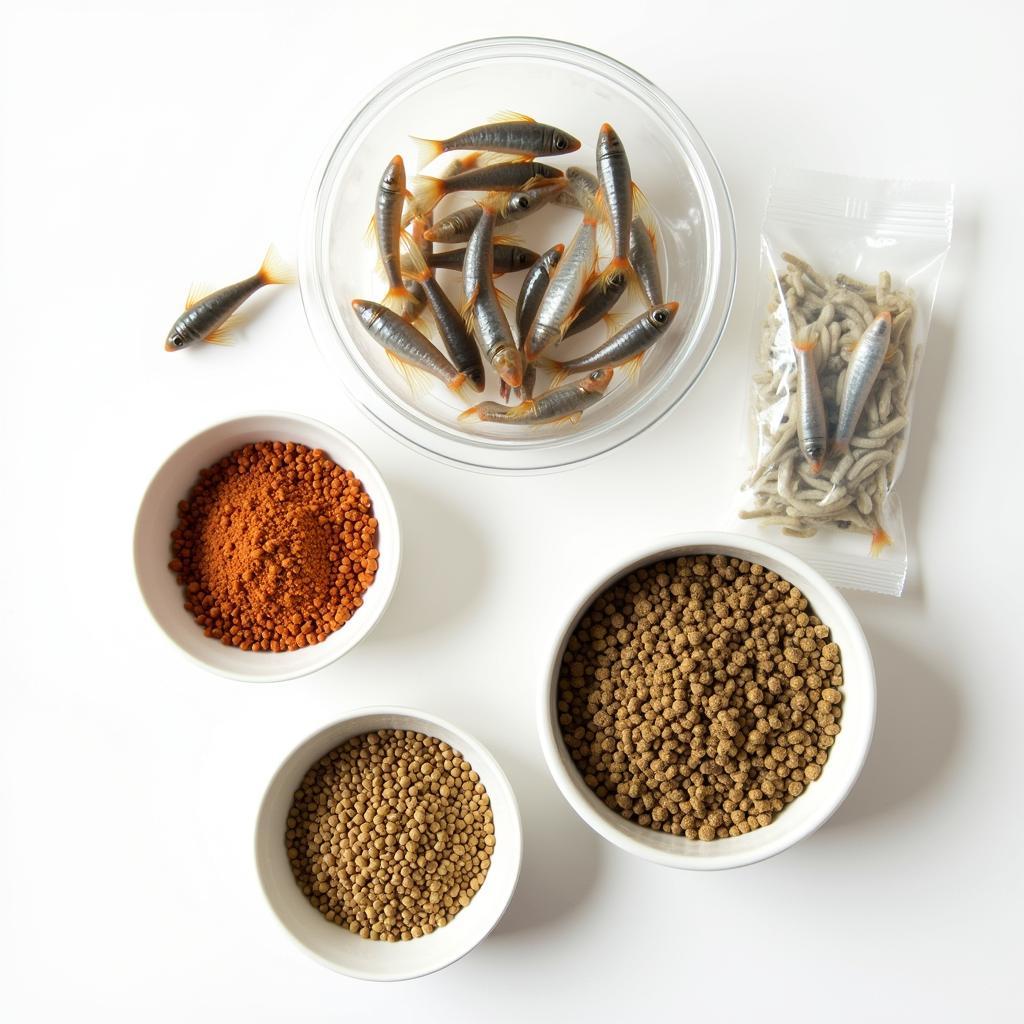Carnivore Fish Food, a crucial aspect of aquarium keeping, ensures the health and vitality of your aquatic predators. Understanding the specific dietary needs of these fascinating creatures is key to their well-being and longevity. This comprehensive guide will delve into the world of carnivore fish food, exploring everything from natural diets to commercially available options.  Carnivore Fish Eating a Smaller Fish
Carnivore Fish Eating a Smaller Fish
Understanding the Carnivore Diet
Carnivorous fish, as their name suggests, primarily consume other animals. In the wild, their diet may consist of smaller fish, insects, crustaceans, and even amphibians. Providing a balanced diet that mimics their natural food sources is essential for captive carnivores. A varied diet helps ensure they receive all the necessary nutrients for optimal health. Many pet owners even incorporate live food like feeder fish or insects occasionally to stimulate their predatory instincts and provide enrichment. This also helps prevent boredom and encourages natural behaviors.
Remember, a healthy carnivorous fish is an active and vibrant one. By understanding their dietary requirements, you can contribute to their long-term health and happiness. A high-quality, protein-rich diet will not only keep your fish healthy but also help maintain the cleanliness of your aquarium by reducing waste and improving water quality.
Types of Carnivore Fish Food
There are several types of carnivore fish food available on the market, each with its own advantages and disadvantages. Understanding these differences can help you make informed decisions about what’s best for your fish.
Live Food
Live food, like feeder fish, shrimp, and insects, is the closest approximation to a carnivorous fish’s natural diet. However, it’s important to source live food from reputable suppliers to avoid introducing parasites or diseases into your tank.
Frozen Food
Frozen carnivore fish food, such as bloodworms, krill, and mysis shrimp, is a convenient and nutritious option. It’s often preferred over live food due to the reduced risk of disease transmission. Freezing also helps preserve the nutritional value of the food.
Dried Food
Dried fish food, like flakes or pellets specifically formulated for carnivores, is another popular choice. It’s cost-effective and easy to store. Look for options with high protein content and minimal fillers.
 Variety of Carnivore Fish Food Options
Variety of Carnivore Fish Food Options
Choosing the Right Food for Your Fish
Choosing the right carnivore fish food depends on various factors, including your fish’s species, size, and individual preferences. For instance, larger predatory fish may require larger food items like whole fish or prawns, while smaller species may thrive on insect larvae or small crustaceans. Do deer eat cat food? They might, but it’s not their ideal diet. Similarly, some fish may prefer certain types of food over others. Experimenting with different options can help you determine what your fish enjoys and what meets their nutritional needs. You can also consult with an aquatic veterinarian or a knowledgeable pet store employee for personalized recommendations.
What do carnivorous fish eat in the wild?
In their natural habitat, carnivorous fish consume a diverse range of prey, including smaller fish, insects, crustaceans, and other invertebrates. This variety ensures they receive a broad spectrum of nutrients.
How often should I feed my carnivorous fish?
Most adult carnivorous fish can be fed once or twice a day, while juveniles may require more frequent feedings. Observe your fish’s eating habits and adjust the feeding schedule accordingly. If you’re concerned about your cat’s diet, explore exigent cat food.
Ensuring a Balanced Diet
Providing a balanced diet is crucial for the overall health and well-being of your carnivorous fish. A varied diet that mimics their natural prey ensures they receive all the essential vitamins and minerals. Just as the food web of a turtle involves a variety of food sources, so too does a healthy fish diet. While aozi cat food might not be appropriate for your fish, understanding the importance of a balanced diet is universal. Consider supplementing their diet with vitamin-enriched food or adding calcium-rich items, especially for species that require higher levels of these nutrients.
“Providing a varied diet is crucial for preventing nutritional deficiencies and ensuring the long-term health of carnivorous fish,” says Dr. Emily Carter, a renowned aquatic veterinarian.
Conclusion
Carnivore fish food plays a vital role in maintaining the health and well-being of your aquatic pets. By understanding their specific dietary needs and providing a varied, balanced diet, you can ensure your carnivore fish thrive in their aquarium environment. Considering different cat food brands like rayne rabbit cat food can be helpful in understanding nutritional needs, even if it’s not for fish.
FAQ
- What are the signs of a malnourished carnivorous fish?
- Can I feed my carnivorous fish vegetables?
- How can I tell if my fish is overfed or underfed?
- What are some common diseases associated with poor diet in carnivorous fish?
- Are there any specific water parameters I need to maintain for carnivorous fish?
- How do I transition my fish to a new type of food?
- What are the best practices for storing carnivorous fish food?
If you need assistance, please contact us at Phone: 02437655121, Email: minacones@gmail.com or visit us at 3PGH+8R9, ĐT70A, thôn Trung, Bắc Từ Liêm, Hà Nội, Việt Nam. We have a 24/7 customer service team.